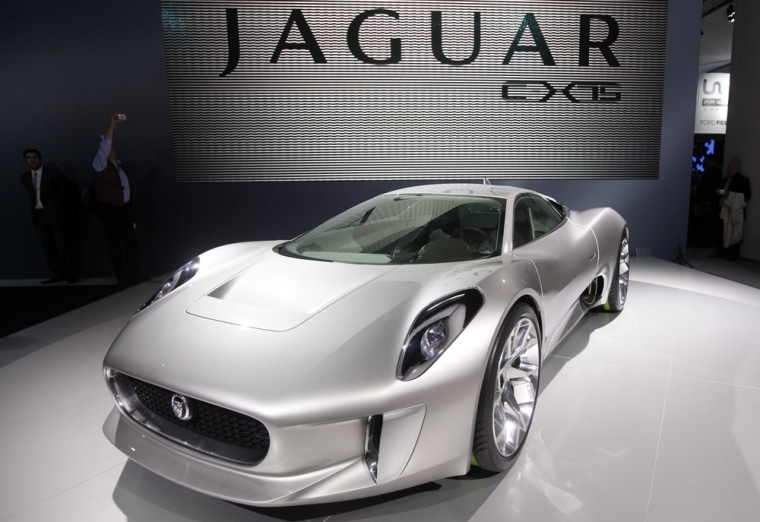Low, sleek and blisteringly fast, the Jaguar C-X75 is generating quite a buzz at this month’s Paris Motor Show.
Turning out an astounding 770 horsepower and 1,180 pound-feet of torque, the prototype promises to not only be one of the most powerful street-legal automobiles on the planet but one of the fastest, launching from 0 to 60 in less than 3.4 seconds, on the way to a top speed of 205 mph. That alone might be enough to impress the Parisians thronging to the biennial Mondial de l’Automobile. But what stands out more is that the supercar does it on battery power.
The C-X75 isn’t alone. A number of high-performance models now on display at the convention center in Paris have turned to electric power, rather than more conventional forms of propulsion.
“Battery power,” former General Motors Vice Chairman and “car czar” Bob Lutz has often pointed out, “has some distinct advantages,” though there’s a downside too, that manufacturers like Jaguar are struggling to overcome.
On the plus side: Electric motors deliver maximum torque the moment they start turning, unlike an internal combustion engine, which has to rev up before reaching the peak of its tire-spinning output.
The downside is the battery. Even the most advanced lithium-ion formulations hold only about 1 percent of the energy, by mass, of gasoline. So that limits range and adds weight, the enemy of performance.
To get the maximum out of its batteries, the Jaguar C-X75 uses four individual wheel motors. That has the advantage of functioning as an advanced all-wheel-drive system, one in which power can be increased to the outer wheels, during a turn, to “vector,” or help steer through a corner.
And when the battery charge runs low, the British supercar switches to an alternative power source, a pair of 77-pound micro-turbines that serve as onboard generators. They can provide power to the wheel motors or help recharge the batteries. At street-legal speeds, Jaguar estimates a 68-mile range on batteries alone, with the C-X75 getting at least another 400 miles on a full tank of gasoline.
In a neighboring hall at the Paris show, Audi is teasing visitors with the eTron Spyder, a convertible version of the high-performance electric sports car the Volkswagen AG luxury subsidiary first previewed at the Frankfurt Motor Show a year ago.
The original coupe relied on battery power alone to reach an estimated speed only slightly slower than the C-X75. But with range sorely limited, Audi has been exploring other options. The new eTron Spyder, like the Jaguar supercar, is a hybrid, using battery and gasoline power. In this incarnation, the 2-seater would use electric propulsion around town then fire up its twin-turbo V6 diesel to push to peak speeds — and extended range.
A novel element of the design is to use the electric motors to drive one axle, and the internal combustion engine would propel the other, creating what the industry refers to as a through-the-road, all-wheel-drive system.
There have been numerous industry reports suggesting the eTron – either in coupe or convertible form – will reach production by early mid-decade. Audi CEO Rupert Stadler demurs, responding only that, “We are listening to the people” to see if there’s a viable market. And, before a decision is made, he hints that other powertrain variations may be tried.
As for Jaguar, new boss Carl-Peter Forster says,” logic would tell us we can’t squeeze in another production program.” But when pressed whether he’d like to let the heart win out in this debate, Forster smiled and admits he and the rest of the Jaguar team would very much like to find a way to make the C-X75 concept a reality.
In yet another hall, Mercedes-Benz CEO Dieter Zetsche confirms that maker is moving ahead with production plans for a battery-powered version of its own supercar, the gullwinged SLS, which reached market for 2010 in gasoline-powered trim.
Until now, battery power has been seen as primarily a way to reduce emissions and improve fuel economy, whether with relatively conventional hybrids, like the Toyota Prius, with plug-ins, such as the new Chevrolet Volt, or with pure battery-electric vehicles, like the Nissan Leaf.
But the industry is well aware that while such products may resonate with environmentalists, nothing fires up the imagination of the automotive enthusiast like a good old-fashioned muscle car. So, the idea of offering a vehicle that can produce zero emissions around town — but then quickly launch to extra-legal speeds — leaves engineers and marketing executives aflutter.
The California battery car start-up, Tesla Motors, bet on the performance factor when it made its first car to market the 2-seat Roadster. A more conventional sedan, the Model S, will follow around 2012. Another start-up, Fisker Automotive, will debut with the sexy Karma, a plug-in hybrid sports car, then launch a sedan of its own.
And the British carmaker Lotus, perhaps most widely known for the knife-edged Esprit supercar seen in the Richard Gere-Julia Roberts film, “Pretty Woman,” is betting on electric propulsion as it stages a major expansion of its brand, over the next several years.
The all-new Esprit, one of five models under development, will be powered by a 5.0-liter V8 making 620 horsepower. But it will be mated to a Kinetic Energy Recovery System, a specialized hybrid-electric system Lotus has developed for its Formula One race car. Performance numbers are on a par with the Jaguar C-X75.
Lotus plans to offer a KERS hybrid powertrain on virtually all its new products. And in the years ahead such technology will likely become less unique as automakers around the world recognize that despite its drawbacks, electric propulsion can offer one very wild ride.
